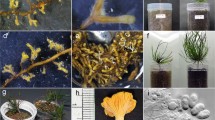Abstract
Morchella spp. ascocarps (morels) are some of the world’s most sought-after mushrooms. Successful cultivation of morels is still a rare and difficult task despite over 100 years of effort. Here we provide the first report of successful Morchellarufobrunnea fruiting body initiation and development in laboratory-scale experiments. Mushroom initials appeared 2 to 4 weeks after first watering of pre-grown sclerotia incubated at 16 to 22°C and 90% humidity. Mature fruiting bodies reached 7 to 15 cm in length and were obtained after the five morphological developmental stages of this Morchella species: sclerotium formation, scelerotium germination, asexual spore formation, formation of initial knots and development of the fruiting body.



Similar content being viewed by others
References
Amir R, Levanon D, Hadar Y, Chet I (1995) Factors affecting translocation and sclerotial formation in Morchella esculenta. Exp Mycol 19:61–70
Boudier E (1897) Révision analytique des morilles de France (Taxonomic revision of the morels of France). Bulletin de la Société Mycologique de France (Bull French Mycol Soc) 13:129–153
Carluccio A (1989) A passion for mushrooms. Salem House Publishers, Topsfield
Constantin J (1936) La culture de la morille et sa forme conidienne (Morel culture and its conidial form). Ann Sci Nat Bot Ser 10:111–129 (in French)
Gessner RV (1995) Genetics and systematics of North American populations of Morchella. Can J Bot 73(Suppl 1):S967–S971
Guzman G, Tapia F (1998) The known morels in Mexico, a description of a new blushing species, Morchella rufobrunnea, and new data on M. guatemalensis. Mycology 90:705–714
Isildak O, Turkekul I, Elmastas M, Tuzen M (2004) Analysis of heavy metals in some wild-grown edible mushrooms from the middle Black Sea region, Turkey. Food Chem 86:547–552
Kuo M (2008) Morchella tomentosa, a new species from western North America, and notes on M. rufobrunnea. Mycotaxon 105:441–446
Masaphy S (2005) External ultrastructure of fruit body initiation of Morchella spp. Mycol Res 109:508–512
Masaphy S, Zabari L, Goldberg D (2009) New long season ecotype of Morchella rufobrunnea from Northern Israel. Mycol Apl 21:45–55
Miller SL, Pilar T, McClean TM (1994) Persistence of basidiospores and sclerotia of ectomycorrhizal fungi and Morchella in soil. Mycologia 86:89–95
Ower R (1982) Notes on the development of the morel ascocarp. Mycologia 74:142–144
Ower R, Mills G, Malachowski J (1986) Cultivation of Morchella. U.S. Patent No 4,594,809
Pilz D, McLain R, Alexander S, Villareal-Ruiz L, Berch S, Wurtz T, Parks C, Mark E, McFarlen E, Baker B, Molina R, Smith JE (2007) Ecology and management of morels harvested from the forests of western North America. USDA General Technical Report, Portland, OR. http://www.fs.fed.us/pnw/publications/gtr710/
Roze ME (1882) Adherence de la base d’appareils ascospores de Morchella sur Helianthus tuberosus. Bull Soc Bot Fr 19:166–167
Shavit E (2008) Arsenic in morels: morels collected in New Jersey apple orchards blamed for arsenic poisoning. Fungi 1:8–16
Twengström E, Köpmans E, Sigvald R, Svensson C (1998) Influence of different irrigation regimes on carpogenic germination of sclerotia of Sclerotinia sclerotiorum. J Phytopathol 146:487–493
Volk TJ, Leonard TJ (1989) Physiological and environmental studies of sclerotium formation and maturation in Morchella. Appl Environ Microbiol 55:3095–3100
Volk TJ, Leonard TJ (1990) Cytology of the life cycle of Morchella. Mycol Res 94:399–406
Weber NS (1995) A morel hunter’s companion: a guide to the true and false morels. Thunder Bay Press, Holt
Acknowledgements
The authors thank Prof. Dan Levanon, Dr. Doron Goldberg and Dr. Ofer Danai for their help. This work was supported by the Office of the Chief Scientist, Ministry of Agriculture, Israel.
Author information
Authors and Affiliations
Corresponding author
Additional information
Purpose of the work The purpose of this work was to study the option of cultivating the saprophytic species Morchella rufobrunnea in a soilless system and its different developmental stages during the process.
Rights and permissions
About this article
Cite this article
Masaphy, S. Biotechnology of morel mushrooms: successful fruiting body formation and development in a soilless system. Biotechnol Lett 32, 1523–1527 (2010). https://doi.org/10.1007/s10529-010-0328-3
Received:
Accepted:
Published:
Issue Date:
DOI: https://doi.org/10.1007/s10529-010-0328-3




